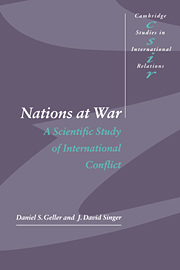Book contents
- Frontmatter
- Contents
- List of figures and tables
- Acknowledgements
- Introduction
- 1 Overview
- 2 Decision models
- 3 War-prone states
- 4 War-prone dyads
- 5 War-prone regions
- 6 War-prone systems
- 7 Case study: Iran/Iraq War (1980)
- 8 Case study: World War I (1914)
- 9 Conclusion
- Appendix 1 List of databases
- Appendix 2 Tables of references by category
- References
- Index
- Cambridge Studies in International Relations
6 - War-prone systems
Published online by Cambridge University Press: 16 October 2009
- Frontmatter
- Contents
- List of figures and tables
- Acknowledgements
- Introduction
- 1 Overview
- 2 Decision models
- 3 War-prone states
- 4 War-prone dyads
- 5 War-prone regions
- 6 War-prone systems
- 7 Case study: Iran/Iraq War (1980)
- 8 Case study: World War I (1914)
- 9 Conclusion
- Appendix 1 List of databases
- Appendix 2 Tables of references by category
- References
- Index
- Cambridge Studies in International Relations
Summary
Introduction
In 1961, Singer noted that the analysis of the international system provides the most comprehensive level for the study of interstate relations. He observed that formation and dissolution of alliances, shifting capability distributions among major powers, and the effectiveness of international organizations and norms all could be subsumed within system-level study. However, 30 years later, Wayman and Singer (1991) state that the production of substantive data-based findings on associations between system-level characteristics and war has been less successful than dyadic-level studies. While this observation is valid, it is nevertheless possible to extract a series of consistent and cumulative empirical findings on war from the quantitative literature on international systems (references listed in appendix 2, table A.4). Many of the difficulties associated with early systemic-level studies stemmed from conceptual ambiguity in the construction of measures or the misspecification of variables. However, these problems do not fundamentally detract from the set of important observations on the factors associated with war-prone international systems.
Polarity/alliance
The literature of international politics is rife with discussions on the effects of the “polarity” of the international system on war. Unfortunately, due to the ambiguity of the concept of polarity and the multiple ways in which it can be operationalized, confusion rather than clarity has characterized the debate. The essence of this confusion involves the question of whether the polarity of the international system is determined by the number of major states or by the number of distinct clusters of states emerging from the configuration of alliances.
- Type
- Chapter
- Information
- Nations at WarA Scientific Study of International Conflict, pp. 113 - 139Publisher: Cambridge University PressPrint publication year: 1998



